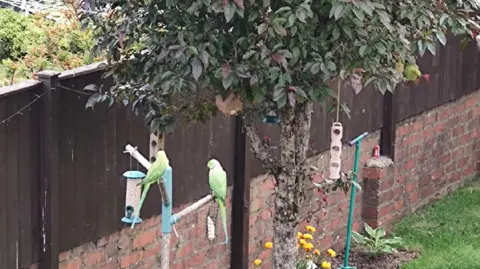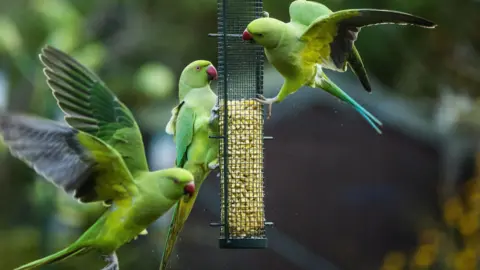Schoolboy finds exotic birds in Swansea park
 Family photo
Family photo- Caleb discovered the ring-necked parakeets in the summer of 2020 at his local park.
- An ornithology expert said the exotic birds are tough, and thrive in urban and suburban environments.
- Ian Fearn, from the Friends of Morriston Park, said the birds have "put Morriston on the map".
In summer 2020, Caleb received his first Ladybird book of ornithology - the scientific study of birds - to help deal with the boredom of lockdown.
At Morriston Park in Swansea, near his home, the then nine-year-old ticked off sparrows, starlings, blue tits…but surely not a ring-necked parakeet?
Parents Mary and Mark thought their son must have made a mistake - the birds are more normally found in Africa and Asia.
But after Caleb took them to visit the site of their nest, sure enough, there was a breeding pair of the birds nesting on their first cluster of eggs.
 Ian Fearn
Ian FearnCaleb said: “I wasn’t sure at first, as I was only just getting into birds, but the parakeets I saw fitted the description in my book."
Three years on, now 12-year-old Caleb visits the family of four or five parakeets each day.
“I was sort of getting into birds at the time, but seeing the parakeets was what really hooked me on ornithology,” he said.
Swansea’s parakeet population is by no means the first in the UK.
Stories of the exotic birds finding homes in the British wild abound as far back as Victorian times, peaking in the 1930s, 1960s and 1990s.
In the 1960s many theories surrounded the origins of the London population in Kensington Gardens, Hyde Park and Richmond Park.
These included guitar legend Jimi Hendrix having released his pet birds as an act of rebellion, and a breeding pair escaping from the Ealing Studios set, where the 1951 classic The African Queen starring Humphrey Bogart and Katharine Hepburn was being filmed.
Studies by the Natural History Museum have since debunked these tales, as DNA samples from London’s population showed them to have originated from many varied sources, not just one or two releases into the wild.
'Big, tough birds'
Ornithologist Emily Shepard, professor of biosciences at Swansea University said: “Although they appear quite exotic, parakeets are actually very well adapted to European conditions, not just here, but across France, Spain and Italy.
“They thrive in urban and suburban environments. They need people nearby who will either discard or deliberately leave out food for them.
“They are big, tough birds, who are quite capable of bullying even jackdaws and crows out of the way of feeders, and in areas with plentiful food supplies they can survive sub-zero temperatures if they can put on enough winter fat”.
She explained that although the precise origins of the Swansea family are unknown, they fit the pattern of other UK populations.
“It seems improbable, but even parakeets who have been domesticated in cages for years have the instinct to survive in the wild once they have the opportunity to escape.
"In the 1930s many were released after a scare around so-called ‘parrot flu’. In 1987 some flew off from damaged aviaries after the October hurricane, so it seems logical that a similar event might have taken place during lockdown, when people weren’t able to care for pet birds,” she said.
 Getty Images
Getty ImagesCaleb, though, has a question: “I get that one parakeet might have escaped from a home in Swansea, but surely there needs to be a daddy and a mummy parakeet for them to have had chicks, and to have gone from one to four or five…?”
Prof Shepard answered: “Urban and suburban parks are their typical environment, so as soon as one area becomes too over-populated or competitive they seem to fly around in search of somewhere else which looks quite similar.
“Once close, their shrill calls can be heard for several miles around. There’s still so much research to be done, but it seems as though this is the way in which the parakeets find each other in order to breed.”
'Morriston is on the map'
Ian Fearn, from the Friends of Morriston Park, said their new inhabitants have given the entire area a boost, and led to a rise in the number of visitors.
“I’m a minister at the Morriston Mission, and every year we visit Nepal to teach under-privileged children.
“When I first heard the parakeets in Morriston Park I had to stop and remind myself quite where I was, as their calls are something I’m more used to hearing in Asia.”
However, Prof Shepard cautioned that the parakeets may not be all good.
“They are a dominant, alien species, without many natural predators other than cats and a few varieties of hunting birds like sparrowhawks.
“They can pose a threat to native wildlife; not only smaller birds, but also bats like the noctule and long brown eared.”
She said there was an active debate around the best way to manage invasive species like parakeets, but for the time being the UK government's Department for Food, Environment and Rural Affairs (Defra) had decided to keep a watching brief.
That’s good news for Caleb, who wants them to stay around.
He said: “I know they can bully other birds, and in Morriston Park they’ve even taken over woodpecker holes, and chased them away".
